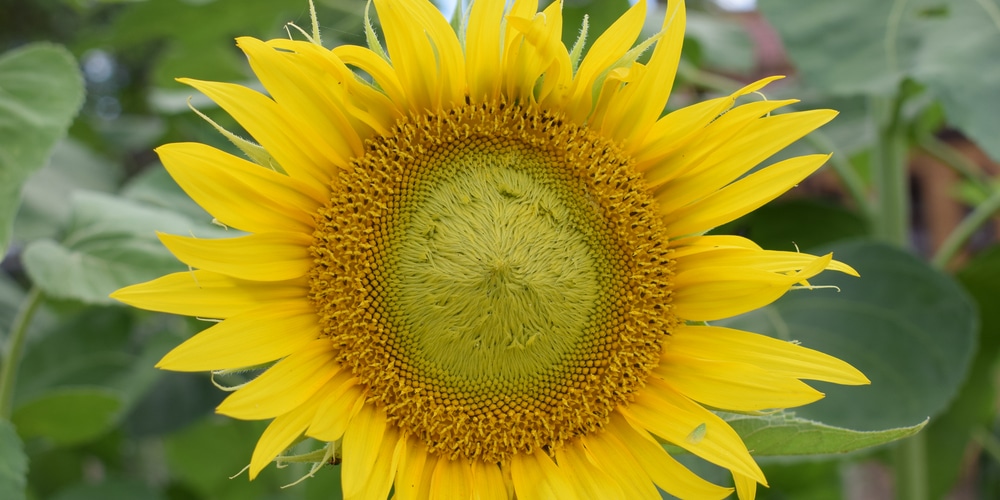If you wish to add wonderment to your home garden that can attract all sorts of flower-loving beneficial insects and birds, planting a skyscraper sunflower is a great way to do just that.
The skyscraper sunflower is a common sunflower cultivar in the United States and typically grows up to 12 feet tall, with some extending up to 15 feet high. Sure enough, this sunflower attracts a wide variety of insects with their large yellow flower heads that turn to face the sun.
Helianthus annuus is known for its masses of flowers that can be seen from far standing on the tall stalks. The flowers also produce hundreds of seeds that can benefit humans and birds.
Notably, skyscraper sunflowers branch into several stems while growing, so each plant ends up having many flower heads. The plants have dark green foliage that blends naturally with their flowers and nearby plants to add a sense of green freshness to your garden.
Planting skyscraper sunflowers in your garden can make it the epitome of attraction with several side benefits. If you are convinced and wish for a sunflower but are unsure how to go about it, this article is a comprehensive planting guide for skyscraper sunflowers (Helianthus annuus).
How to plant skyscraper sunflower
This variety of sunflower is unique in its height and large flower heads. Like other sunflower varieties, it grows best in a sunny spot that receives a minimum of 6 hours of direct sunlight daily.
It also does best when planted in the ground and not in pots. Here is a basic guide for planting sunflowers of the variety Helianthus annuus.
1. Choose the right seed variety
There are different sunflower varieties. When planning to plant, always conduct research and make sure to select the giant long variety. For easy identification, choose seeds whose names or descriptions have terms like kong, tall, mammoth, giant, or monster. Beware that all seed brands have variations in terms of height and maturity time.
2. Select a planting site
As the name suggests, sunflowers require plenty of sun to thrive. Select a planting spot that receives full sun, at least 6 to 8 hours of sunlight daily during the growing season. Also, when selecting the planting area, keep in mind that the stalks of sunflowers are quite weak and can be easily broken by wind and storms.
Therefore, choose a spot with wind barriers or breakers that can reduce the strength of winds reaching these flowers. You can plant the flowers beside the house or trees, but ensure the windbreakers do not block sunlight.
3. Prepare the growing area
Till the ground appropriately, turning the soil repetitively to remove weeds and loosen the soil. Sunflowers prefer fertile, well-drained loamy soil.
If your garden has poorly drained, less fertile soil, you can add compost manure and mix it well into the soil to enhance drainage and improve its nutrient profile. A layer of mulch can also be a great addition if you need to boost the soil’s ability to hold adequate moisture for the plants.
4. Plant sunflower seeds
You can either start sunflower seeds indoors or plant them directly on the ground. For indoor starts, plant seeds in small containers and wait until they sprout.
Once they produce a few leaves, transplant them to larger containers. This should be done in winter as you await the right time to plant outdoors when the weather conditions are favorable.
Before transplanting sunflowers to the ground, it is essential to harden them by slowly introducing the plants to the outside conditions to reduce transplant shock that can kill most sunflower seedlings.
For outdoor planting, do it in spring, after the soil has warmed up and is free from the dangers of frost. Prepare holes of about ½ inch depth, leaving a space of about 8 to 12 inches between holes and about 24 inches of space between lines. This space is needed to give the skyscraper sunflowers room to establish their roots and spread out their branches.
When planting, it is recommended to plant only one seed per hole. Helianthus annuus grow very large and develop branches, so each plant requires space.
5. Watering and mulching
Sunflowers are relatively drought resistant and may not require a lot of water once they establish in the soil. However, during the first few days of planting, you need to water the seeds or transplants. After placing seeds or transplants in the ground, cover with soil and add water until the soil is damp.
Add a layer of mulch to every hole to help maintain soil moisture. This water will help in seed germination and root establishment. Thereafter, reduce watering because too much water can cause root rot, which eventually kills the entire plant. Mulching also helps maintain soil warmth which is essential for germination.
6. Adding fertilizer
Apart from choosing the right variety, fertilizer also helps determine the tallness and flower size you will have in your garden. Even so, be cautious not to over-fertilize or under-fertilize your plants. It is advisable to use organic fertilizer as it releases nutrients in the soil slowly but for a longer time.
Skyscraper sunflower: Conclusion
Skyscraper sunflowers are among the best annuals you can choose to add to your garden. The planting process is simple, and the plants are low maintenance.
All you need is a sunny spot with fertile, well-drained soil with windbreakers to protect the plant from strong winds and storms.
Related Article: How Late Can You Plant Sunflowers?

